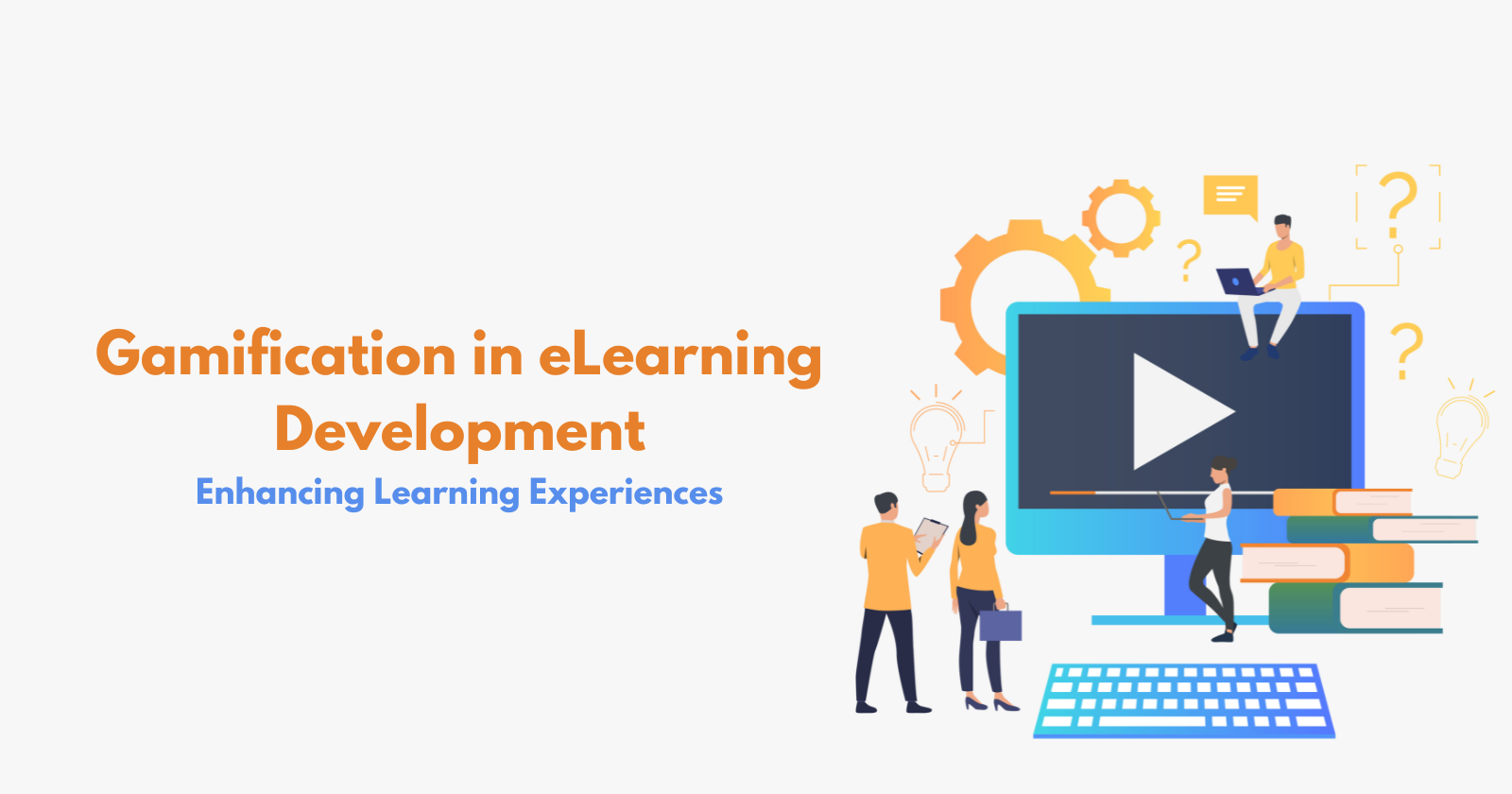The Role of Gamification in eLearning Development: Enhancing Learning Experiences
 Dipen Patel
Dipen Patel
In a world where instant gratification has become the norm, traditional learning methods often fall short. Those days are gone when education was confined to textbooks and classrooms.
Today, eLearning offers a dynamic and flexible approach, making education more accessible and tailored to individual needs. It provides easy, often free access to a variety of online courses, virtual classrooms, and interactive modules, adapting to diverse schedules and needs.
But even with these advancements, one challenge remains: Keeping learners engaged and motivated.
To tackle the engagement challenge, gamification came into play around 2010. This clever approach takes elements from games—like rewards, progress tracking, and a bit of competition—and brings them into the learning world.
The result?
More involvement, better learning, and a boost in motivation.
This is not it…
Stick around with us till the end to get to know how these game-like elements are transforming learning experiences into something truly exciting.
What’s Gamification All About?
In layman's terms, Gamification basically, means adding game-like elements to things that aren’t games to make them more fun and engaging.
In eLearning, gamification works by turning lessons into interactive experiences. Instead of just reading or watching videos, learners can earn badges, track their progress, and take on challenges, all of which make learning feel more like playing a game.
This approach helps keep people motivated and makes the whole process a lot more enjoyable.
So, how does this playful approach compare to traditional learning?
Let’s break down the top 5 ways gamification differs from the old-school methods, especially when it comes to keeping learners engaged and interacting.
Aspect | Gamification | Traditional Learning |
Engagement | Uses points, badges, and challenges to keep interest. | Relies on lectures and texts, which can be less engaging. |
Interaction | Promotes active participation through interactive elements. | Often passive with limited interaction. |
Motivation | Provides immediate rewards and progress tracking. | Motivation comes mainly from grades and personal goals. |
Feedback | Offers instant feedback to quickly adjust learning. | Feedback is usually delayed, impacting timely improvements. |
Experience | Creates a dynamic, game-like learning experience. | Often follows a static, structured approach. |
With these differences laid out, it’s clear how gamification makes eLearning not just easier, but also a lot more fun.
How Gamification Boosts eLearning?
Gamification brings a range of benefits to eLearning, and as technology evolves, we can expect even more exciting innovations.
Here’s how gamification makes a difference in e-learning development:
Increased Engagement: Gamification makes learning more engaging by adding game-like elements such as points, badges, and leaderboards. These features turn learning into an interactive experience that’s both fun and motivating. When used in custom eLearning development, these elements can be designed to fit specific learning goals, keeping learners interested and involved.
Enhanced Motivation: Rewards and progress tracking are key to keeping learners motivated. By offering immediate feedback and tangible rewards, gamification encourages learners to stay on track and reach their goals. This approach helps create more compelling Edtech Solutions that keep learners driven and focused.
Improved Retention: Interactive content through gamification helps learners remember information better. Games and challenges make lessons more engaging and memorable, which means learners are more likely to retain and use what they’ve learned. This is a big plus in e-learning development, ensuring that knowledge sticks longer.
Personalized Learning: Gamification allows for personalized learning experiences by adapting to each learner’s progress. It tracks achievements and provides custom feedback, making the learning journey tailored to individual needs. This is especially useful in custom eLearning development, where personalized content can make learning more effective and relevant.
Top 4 Effective Gamification Strategies:
Implementing effective gamification strategies can significantly boost engagement and effectiveness in e-learning and Edtech Solutions.
Game Mechanics: Introducing game mechanics like points, badges, and leaderboards can make learning more engaging and fun. Points and badges reward learners for their achievements, while leaderboards introduce a friendly sense of competition. These elements keep learners motivated and actively participating in their educational journey.
Interactive Storytelling: Interactive storytelling involves creating engaging narratives and scenarios that draw learners into the material. By presenting content through stories or real-life scenarios, learners can explore concepts in a more immersive way. This approach helps make the material more relatable and memorable, enhancing the overall learning experience.
Feedback Loops: Instant feedback is crucial for driving learner improvement. Gamification often includes features that provide immediate responses to actions, helping learners understand what they’ve done right or wrong. This timely feedback keeps learners on track and helps them make adjustments as they go, improving their overall progress and performance.
Social Learning: Adding elements like leaderboards and collaborative challenges can boost social interaction among learners. Leaderboards foster a sense of competition, while collaborative challenges encourage teamwork and communication. These social aspects make learning more interactive and enjoyable, as learners can share experiences and support each other.
How Gamification Is Making a Real Impact
There are so many great examples of gamification working wonders in eLearning that it’s hard to pick just a few. But some stand out.
Duolingo, for instance, has nailed it by turning language learning into a fun game with points, badges, and streaks that keep users coming back.
Khan Academy does something similar with math, making tough subjects feel more like an exciting challenge than a chore.
These days, Edtech solutions are embracing gamification to change the way we learn. By mixing in-game mechanics, storytelling, and social elements, they’re making learning more engaging and personalized.
The result?
Learners are not only more involved and remember more, but they also enjoy the process a lot more.
Tackling the Challenges of Gamification
While gamification can be a game-changer for eLearning, it’s not without its hurdles. Striking the right balance and ensuring seamless integration into existing platforms can be tricky.
However, with the right approach, these challenges can be effectively managed.
Finding the Right Balance: While gamification can make learning more engaging, it’s crucial not to overdo it. If you pile on too many game elements, it can overwhelm learners and take the focus away from the actual content. The trick is to use gamification thoughtfully, so it adds to the learning experience without overshadowing the material.
Designing with Purpose: Good design is at the heart of effective gamification. It’s not just about making learning fun—it’s about making it meaningful. Understanding your audience and ensuring that every gamified element serves a real educational purpose is key. You want these features to truly enhance the learning process, not just act as a distraction.
Smooth Integration: Bringing gamification into existing eLearning platforms requires careful planning. It’s important to make sure that these new features fit seamlessly with what’s already in place. Sometimes, this might mean doing some custom eLearning development or finding the right Edtech solutions to ensure everything works together smoothly.
Future Trends
Emerging Technologies: Briefly explore how AR/VR and AI are influencing gamification in eLearning.
Predictions: Future trends and innovations in gamified learning.
Conclusion
The eLearning industry is on an exciting trajectory, with a forecasted growth of $325 billion by 2025. This rise is driven by several transformative trends. Artificial Intelligence (AI) is becoming a cornerstone in eLearning development, enhancing personalized learning experiences and driving engagement through advanced analytics and adaptive learning technologies.
With AI’s market in education expected to surpass $30 billion by 2030, its impact is undeniable. Mobile learning continues to gain traction, with users increasingly accessing educational content via their smartphones, making learning more flexible and accessible.
As educational institutions and businesses alike adopt these Edtech Solutions, the focus is shifting towards a hybrid approach that blends traditional and digital methods. This trend underscores the growing demand for custom eLearning development that adapts to individual needs and preferences.
If you're thinking about diving into this space, having skilled AI/ML developers on your team can make all the difference.
Subscribe to my newsletter
Read articles from Dipen Patel directly inside your inbox. Subscribe to the newsletter, and don't miss out.
Written by

Dipen Patel
Dipen Patel
Dipen is an expert when it comes to Software Development & Programming in Full-stack and open-source environment. He has been working as the Chief Technology Officer at Quixom, providing a wide range of IT solutions to startups around the world. He is always up for a challenge. He works on building systems and solving problems at Quixom. When he is not working, he loves to watch movies and listen to music.